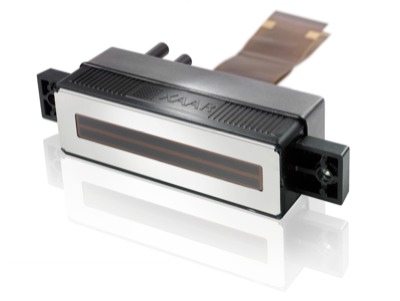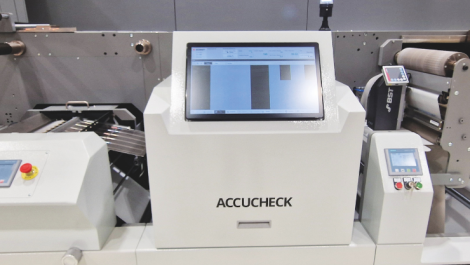Xaar 1001 recirculating printhead
The quality and productivity of inkjet is inexorably improving, with better cost performance for longer runs. White has been a problem in the past, but no longer with good opacity and coverage now available. In 2013, installations are ramping up and there are many satisfied users making money and satisfying customers with the technology, says Sean Smyth.
Inkjet has been hyped as the future technology of choice for years, but it still lags behind toner printing in adoption in labels and packaging. At the high end, EFI Jetrion has sold the most presses, but it is well behind both HP Indigo and Xeikon in terms of its installed base.
The inkjet head technology is still developing, to deliver improved quality, and importantly reliability, together with ink formulations. Xaar holds an important position in narrow web designs with the Xaar1001 used in EFI, FFEI/Caslon, StorkPrints, Durst, Linoprint (and CSat), Systec (INX Digital), Atlantic Zeiser, Founder Electronics and JF Machinery systems, amongst others, but it is not alone. Konica Minolta has a lot of success through its Cambridge-based reseller, Industrial Inkjet Ltd, and in the sheetfed KM-1 B2 press, while Kyocera heads are used in the Domino N600i and Screen’s Truepress Jet L350UV. Fujifilm Dimatix heads are in the sheetfed JetPress, including the JetPress F aimed at cartons. Epson uses its own micro-piezo heads in the SurePress L-4033A label press that uses water-based ink.
All in the head
There has been much development in inkjet heads, with new improved models being announced and brought to market. The patent literature highlights lots of activity that has not entered in the commercial cycle yet that will be years away from development. There are several trends in the market, with heads generating smaller drops (for precise placement leading to better quality) at higher speeds.
Headquartered in Kyoto, Japan, Kyocera is active in many consumer and business-to-business sectors including printers, with the inkjet division part of the Thin Film Component Group at the Kagoshima Kokubu plant in the south of the country. There are a range of KJ4 heads, with UV and aqueous ink systems at various speeds and drop sizes.
Konica Minolta offers the new KM1024i head with air cavities, rather than the shared wall design of the previous models. It features four rows of nozzles and each ink channel is separated, allowing total control of each channel.
FujiFilm Dimatix has been promoting its MEMS manufactured range of heads for some time. The high performance Samba heads are effectively extensible ‘printheads on a chip’, individual modules containing 2048 nozzles in a rhomboid some 20 mm wide that can be closely packed into continuous arrays.
Memjet heads are being used in the high performance Colordyne engine, in the lower cost RapidX machines from ITE and the Vortex 825 launched in February by Reprographics Technology International. The development cycle on all printheads is still accelerating and this will push the technology forward, improving quality, speed and economics and accelerating the analogue to digital transition in print and packaging.
Of course, having a print system that is capable of reasonable quality is no guarantee of commercial success. The inkjet system suppliers have gained experience across the label sector and are providing more appropriate solutions, with white and good links to new and existing finishing systems.
The ongoing developments in head technology, ink systems, equipment design and control software and electronics will be the key enablers in inkjet increasing its share of the label and packaging market over the next few years.
Read the full story in the April issue of Digital Labels & Packaging






